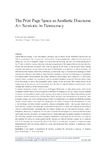Mostrar o rexistro simple do ítem
The Print Page Space as Aesthetic Discourse Art Semiotic in Democracy
| dc.contributor.author | Gobbett, Tania Letizia | es_ES |
| dc.date.accessioned | 2014-10-02T12:31:07Z | |
| dc.date.available | 2014-10-02T12:31:07Z | |
| dc.date.issued | 2012 | es_ES |
| dc.identifier.citation | Culture of communication / Communication of culture, 2012: 2021-2035. ISBN: 978-84-9749-522-6 | es_ES |
| dc.identifier.isbn | 978-84-9749-522-6 | es_ES |
| dc.identifier.uri | http://hdl.handle.net/2183/13292 | |
| dc.description.abstract | [Abstract] Roland Barthes writing, to the zero degree, seemed to put its accent on the differences between art and craft as a question of style, mannerism: writing limits, merges, proportions, isolate, build its own social reality, but is it still a thoughtful shape? Or it is the suit, the envelop, the skin, of a constitutional part of the ‘I’, that revolts this scenery, that renews the pact as agreement of the rights of the person, the individual outside the conveniences as before 1996 were the ground of the usury of any political term? Among linguistic and semiotic we can discover the traits of differences as to perceive its eidetic necessity, the elements and the objects. Since Erik Landowsky, in which the page is structured as a painting of spaces connotations, oblique to the reader or since Giovanni Anceschi where the art of the page it is experience of communication, the occurrence, the author, inference a social space and a collective «I», the subject restrain, closes, exemplify or even models what is expanded, translated, loosened. From the identity body of the newspaper we get to the unreachable public identity of the consumer. The chiastic gesture or the censure one, or the polisemic as it is involved just in the object: it should impress a certain quality of the message and continuity of the communication. A semiotic landscape, in some of the terms of Ruggero Pierantoni, of light phenomenon, while on the newspaper could be seen in its own categories exploited as re-reading a townscape, as the voyageur propose a journey, the compositions aspects may represent some ways to renew the fragmented process, pauses, attitudes to rebuild a reader theory. To Jean Marie Floch, the page is the emergences of the meaning: utters as sudden wriggle, out of the waving envelop. If there is a mania that is to compare the different corporate identity without results, as to forget the composition, the athletic heritage of the development; but here is the challenge: the irony become quotation, through a passionate writer – the pigiama seems only to create the deal, the game, the landscape in a possible recognition of a certain time braking the appearances between words and deeds, knowledge and real objects. Subjectivity is in the semiotic montage: where it disappears, democracy is forgotten. To Giovanni Anceschi the newspaper is a communicational artefact that sculpts, models, our history: its typefaces are still means that signs the melodic registry of counterfeit? We will bring together some pieces of graphic experiences, some deep lecture and irony as vocation, and compare the voices as textual genres and the typefaces as tools for semiotic culture: as in a painting of J.-L. T. Gericault, the relicts of The Raft of The Medusa, to demystify the genres, to rediscover some anthropological calls for cultural objects in visual communication from painting to architecture, from sculpture to print. | es_ES |
| dc.language.iso | eng | es_ES |
| dc.publisher | Universidade da Coruña | es_ES |
| dc.title | The Print Page Space as Aesthetic Discourse Art Semiotic in Democracy | es_ES |
| dc.type | info:eu-repo/semantics/conferenceObject | es_ES |
| dc.rights.access | info:eu-repo/semantics/openAccess | es_ES |






